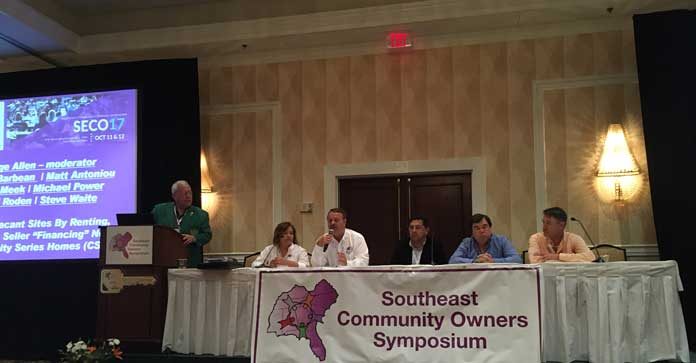Rent, Sell and ‘Seller Finance’ Your Way to 100 Percent Occupancy
Manufactured housing community owners at SECO17 on opening morning provided quick tips for community owners who want to fill vacant sites.
Moderated by community owners and industry leader George Allen, the panel included community owner and operators Maryuri Barbean, David Roden, Joe Lahore, Michael Power and Chuck Meek.
Speaking to a full room of seasoned, new and prospective owners, Michael Power quickly advised to focus on the property itself as a first step, rather than putting too much early emphasis on buying new homes.
“It is profitable to be a good steward of your property,” Power said. “You first have to take
an inventory of things you need to do on your property, whether you need to pave road or whatever else.
“If you really want to sell new or used homes, you have to create 100 percent compliance,” he said. “We clean up the community and enforce the rules.”
Creating the standard for a clean, safe place for residents will generate more lease agreements and homes sales in the long run than putting in two new model homes. However, a pair of new models will serve a purpose once a community is stabilized.

On the topic of community feel, and safety, David Roden, president of Mountain View Estates and co-founder for SECO put an emphasis on quality lighting.
“Our community is lit up like a Christmas tree,” he said. “A lot of people who are looking for a place to live drive through at night, and this makes a big difference.”
Home Types to Fill Vacant Sites
A question from the seminar audience of 200-plus people asked about the preference toward smaller or larger homes.
“Our residents like doublewides, and that’s most of what we’re doing. When they walk in, they feel like it’s a conventional house,” said Maryuri Barbean, of Pentagon Properties. “That’s what we’re hearing most often. If we set up a single- and double-wide, we are selling the double-wide first.”
However, other community owners at SECO said the size of the home depends largely on community design, keeping consistent with the nature of existing homes.
“We have a limited amount of space, and really are only interested in single-wides,” Meek, of Calhoun Homes, said.
Power pointed out that there are gray areas to consider, with the availability of larger single-wides that fit both bills. “Look in your local market and see what’s available,” he said.
The Southeast Community Owners Symposium assists community owners in making business decisions in a non-competitive environment. This year’s event is held Oct. 11-12 in Marietta, Ga.
Also, Barbean noted the importance for owners and community managers to reach out to the wider community. It helps to build relationships with the schools, churches, local business and law enforcement, for instance. It does help to fill vacant sites, but does so much more.
“We had a church come in an provide 100 kids in the community with Christmas gifts,” Barbean said. “It was amazing, and so important.”
How to Screen Prospective Tenants
Community owners agreed that a prospect should have no criminal record, no evictions and no large or aggressive pets. Also, the prospect should monthly income that equals or exceeds three times the amount of monthly payments.
“Get a good application, but it’s just as important to meet and talk with the prospect. Shake hands, walk them to their car and thank them for coming in. After a while in the business, your gut instinct will not fail you,” Roden said.
The MHVillage/Datacomp team is involved in various aspects of SECO17, including sponsorship, seminar presentation, and vending. The MHInsider blog for Professionals will continue through the next two days to report items of interest from SECO17.










